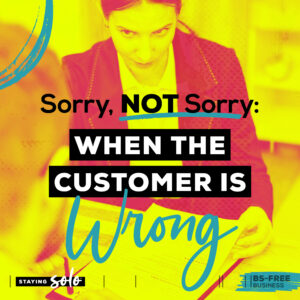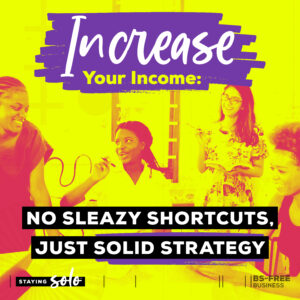
Search the site:
The Capacity Code: Managing Time and Energy as a Solo Business Owner
The time vs. money trap is REAL, and if you feel like you’re in an endless loop of working more to make more and then melting down, you’re not alone.
While hustle culture might still be alive (and unwell), for solo service business owners, it’s a fast track to being seriously stuck. Today, we’re diving into how to create your Capacity Code—a way to manage your time, energy, and emotional bandwidth so you can break free from the time vs. money trap for good.
Listen to this episode now:
Raise your hand if you look at your to-do list and have no idea how you’re doing to get it all done. Raise your other hand if you’re constantly running into this issue and aren’t sure how you will ever make more money.
If you’re feeling personally attacked now, you’ll want to hear what I share in this episode.
As a solo business owner, you wear many hats. Even if you have support, there’s ALWAYS something and that can quickly and easily lead to overextension.
Yet celebrity entrepreneurs reinforce the myth that “hustling harder is the key to success.” While many of these people are now preaching the “soft life,” they’re rewriting history as they hustled their way to what they have now and are completely out of touch with reality.
Hustling harder to be successful or make more money isn’t the only way. This myth completely overlooks that we’re more than our work and need a life while tending to our health and mental well-being. Honestly, it’s some real bullshit.
You can’t start managing your capacity when you’ve “made it,” like these celeb entrepreneurs do. You can’t wait until you’re completely burnt out.
When I created the Staying Solo Framework, I deliberately included the pillar of space: You must proactively and intentionally manage your capacity.
By operating over your capacity and not prioritizing space in your business or life, you may be physically or mentally exhausted, experience decreased motivation, diminished satisfaction, or resentful. And that’s just the personal impact. Then there’s the potential for a slip in the quality of your client work, missed deadlines, poor communication, and even client churn or reputational damage.
None of this is why you started your business, and it’s completely unsustainable. But what happens when you’ve done the basics and it’s just not cutting it anymore?
It’s time for how you think about your capacity to evolve.
Table of Contents
The Evolution of Capacity Management
Managing capacity, or what I refer to as “space,” is one of the more challenging aspects of being a solopreneur. This discussion cannot be had without acknowledging that we’re trading time for money, no matter what we do. That’s the nature of work, and we need to stop believing that the solution is to stop trading time for dollars.
Recognizing this helps you pay more attention to their capacity, particularly your time. To date, you’ve probably done some work to ensure you’re not working all hours of the day, taking weekends off, scheduling vacations, and being a better steward of your schedule overall.
Those are foundational elements of managing your capacity, but I promised you the “graduate level” look at strategy, salary and space. When you only think about capacity or space in terms of time, you’re limiting yourself and failing to account for other critical pieces of the puzzle.
If you’ve been focused on time up to this point, there’s nothing wrong with that. Time is a natural place to start, as it’s something we can quantify. Let’s be honest: so much of what makes capacity management a challenge is that it’s intangible.
However, as your business evolves and grows, taking only a time-based approach to your capacity isn’t enough. This is particularly true if you find yourself in the time vs. money trap, where no more time is left.
This looks like constantly juggling multiple deadlines, managing higher client expectations, and feeling the weight of every decision you make.
It’s easy to fall into the trap of thinking, “I should have this all figured out by now,” but let’s be honest—even the most seasoned professionals need to adapt their strategies as they go.
The strategies and tactics that worked when your business was smaller or simpler likely aren’t cutting it now. That’s why you must be ready to evolve, especially if you’re stuck in the vicious circle of the time vs. money trap.
Creating Your Capacity Code
Enter what I call The Capacity Code—a personalized system for managing your time and energetic, emotional, and sensory capacity in a way that supports your business and your life.
The goal is to move from constantly being stuck in the time vs. money trap by shifting your focus to managing your most valuable resources—time, energy, and emotional capacity—more strategically and sustainably.
Most importantly, your Capacity Code is unique to you and not something I can easily prescribe. Each of you has different requirements and needs that need to be factored into your capacity management.
Use the following questions to create your Capacity Code. Recognize that some areas may require more attention than others right now.
What Are My Current Capacity Limits?
Understanding your current capacity limits is essential for maintaining a sustainable workload and reaching your goals.
Start by closely examining your daily tasks and responsibilities to identify where you might be stretched too thin. This means recognizing the boundaries of your physical, mental, and emotional capacity and being honest about what you can realistically handle.
As part of this assessment, reflect on how often you feel overwhelmed or exhausted by your work. Are there specific tasks that consistently drain your energy or leave you feeling burnt out? Also, consider which clients or projects push you beyond your capacity, demanding more time, energy, or resources than you have available.
By pinpointing these stressors, you can start to make informed decisions about where to set boundaries, what to delegate, and how to adjust your workload to better align with your capacity. You may even need to switch up the services you offer or clients you work with
Recognizing these limits isn’t a sign of weakness—it’s about protecting your health, maintaining high-quality work, and ensuring your business thrives in the long run.
Is My Schedule Aligned with My Capacity?
Ensuring your schedule aligns with your available space may seem extremely basic, but trust me when I say this is an advanced tactic.
The time vs. money trap is real, and if you’re always trying to cram more and more into your schedule, you’re likely to end up sacrificing more of your time. Eventually, you’ll reach a point where that just doesn’t work anymore.
You may feel like you don’t have any choices and that you have to accept certain things as inevitable. (Such as how many calls you have on the calendar.)
When I discuss this with clients, I encounter a lot of resistance, as they believe that whatever they’ve been working on is the only way. The good news is that’s completely untrue. They can change their schedule to meet their needs.
As a reminder, you have agency over your schedule and calendar. Implementing small changes as part of your Capacity Code can make a tangible difference in how you feel about your work, how much money you can make, and more.
So, instead of kicking the can down the road to deal with it later, you need to start making it more manageable now.
Which Tasks and Activities Are Essential to My Business Success?
Not all tasks or activities impact your business in the same way, so you need to figure out which ones directly contribute to your growth, profitability, and long-term goals. By focusing your limited capacity on what matters most, you ensure that your time, energy, and resources are being invested where they will have the most significant impact.
Start by evaluating your daily and weekly tasks. Which ones are directly aligned with your business objectives? Prioritizing these tasks ensures that your efforts move the needle in your business.
At the same time, it’s crucial to recognize which tasks are less critical or could be handled more efficiently. Look for opportunities to automate repetitive or time-consuming tasks—invoicing, scheduling, or email management—using tools and technology to streamline your operations.
Additionally, consider whether there are tasks that could be eliminated, freeing you from activities that don’t add value to your business.
If you’re struggling with prioritization, you may want to use the Eisenhower Matrix, a tool for categorizing tasks based on urgency and importance. In the context of the time vs. money trap, I encourage you to go beyond the urgent/important tasks and also factor in the time and money involved.
As a solopreneur, it’s easy to focus on tasks that take up a lot of time but generate little to no income. These may be pointless administrative tasks, busy work, or even low-paying, very demanding clients.
Where Are My Energy Leaks?
Energy leaks are subtle, sometimes sneaky, drains on your energy that can add up over time.
When you work with clients, there will always be an energetic toll, and it’s not just “difficult” clients. It may be the type of work you do and how much you can do in a given day without being destroyed.
All of this must be factored in so you can proactively make decisions that support and protect your energy.
For example, you have five retainer clients; two are incredibly high-energy, and calls with them are exhausting. You can control that energy leak by minimizing calls and ensuring you take steps not to talk to both of your high-energy clients on the same day.
Sometimes, you’ll be your worst enemy and end up paying the price afterward. (Especially if you’re disabled, neuro-divergent, have mental health challenges, or are introverted.) Take note of where this happens and take steps to stop it from continuing to happen.
I want to share an example from one of my clients about what this can look like. This creative entrepreneur found herself in a situation where she was up against some aggressive demands and deadlines. As much as she liked these clients, It was sucking the life out of her as she didn’t have the space she needed to do innovative, creative work. She decided she had to level with them and reset how they worked together so that the work wouldn’t suffer and she could manage her time and energy.
Guess what? The client understood, and she didn’t need to just go with what they wanted. The energy leak is fixed!
What Boundaries Do I Need to Set to Protect My Capacity?
As a solo business owner, you need to establish clear boundaries that prevent overcommitment and ensure you have the space to rest, recover, and maintain a healthy relationship with your work.
Without these boundaries, it’s easy to fall into the trap of saying yes to every opportunity, client request, or project that comes your way, which can quickly lead to burnout and diminish the quality of your work.
Even if you have boundaries in place, you likely need some new ones, especially if you’re stuck trying to figure out how to escape the time vs. money trap.
Your Capacity Code needs to address anywhere you feel like you’re not in control, falling into a pattern of people-pleasing, or engaging in other behaviors that lead to you overriding your available capacity.
Consider where you may need boundaries around the number of clients you work with, the hours you work, the type of work you do, communication, and so on.
Identifying how you can build on your existing boundaries will help ensure you’re not wasting precious time or energy where it’s not needed.
How Am I Managing My Emotional Capacity?
Your emotional capacity is as vital to your success as your time and energy, so you must regularly assess how well you handle the emotional demands of running a business, including stress, setbacks, and client relationships.
To start, reflect on your current emotional state. Are you frequently feeling overwhelmed, anxious, or frustrated? Do certain situations or clients trigger heightened stress or negative emotions?
Understanding these emotional patterns can help you identify areas you might need to adjust as part of your Capacity Code. It’s important to recognize that emotional capacity isn’t infinite; like any other resource, it must be managed carefully.
Once you’ve assessed your current emotional capacity, consider what practices you can implement to manage stress better and maintain emotional balance. This will vary on an individual basis, but it’s vital you have a game plan for what works best for you.
You may need to take more breaks, meditate, go for a walk, or check in with a supportive community. You could also go to therapy or add more sessions.
For many clients, it’s getting outside or reading a book. The key is that it helps you ensure your emotional well-being as a business owner because it’s really hard to break free of the time vs money trap when you’re feeling like an emotional hot mess.
How Can I Create a Work Environment That Truly Supports My Capacity?
Consider what changes you can make to improve your focus, comfort, and efficiency. Whether decluttering your desk, optimizing your digital tools, or adjusting your workspace layout, creating an environment that works for you can significantly affect how effectively you manage your capacity. Plus, your work environment impacts your sensory capacity—are there sights, sounds, or other sensory inputs draining your focus and energy?
Creating an environment that limits unnecessary sensory stimuli allows your mind to relax and concentrate on the task.
For instance, noise-canceling headphones, adding soft lighting, or organizing your workspace to reduce clutter can help create a calming atmosphere. These minor adjustments can greatly affect how comfortable and productive you feel throughout the day.
Managing Your Capacity Code
Once you’ve explored those questions, you likely know where you need to focus in the short term to start freeing up more space. This brings us to the fact that creating your Capacity Code isn’t a one-and-done deal.
I’m 19 years into running my own business, and I’m going to level with you: managing your capacity requires ongoing effort.
As more and more celebrity entrepreneurs see that we’re all sick of the hustle, they speak more about having softer and more sustainable businesses. However, most of what they talk about isn’t meant for solo business owners, and it’s a gross oversimplification. You don’t have the same support or resources they have, and often, their recommendations leave you frustrated and irritated.
Plus, it’s not about one-size-fits-all solutions or quick fixes; managing capacity requires effort and patience. The good news is that it gets easier as you dial in your Capacity Code, and you’ll learn what best supports you.
If your Capacity Code is always a work-in-progress, you’re likely wondering how to measure progress.
You need to decide what “success” looks like for you. That’s why I recommend you define several indicators so you can check in on them either monthly or quarterly.
If you’re not sure what to use as an indicator, it can be:
- Reaching your revenue goals without overworking
- How many hours you’re working
- How you’re spending your work time each day or week
- Feeling relatively little stress,
- Not experiencing overwhelm
- Having time to do strategic or creative work for your business
- Taking time off
The other consideration is that you need to regularly assess and adjust your Capacity Code as it evolves with your business and life changes. Set a regular check-in (weekly or monthly) so you can spot the signs you’re reaching (or exceeding) your capacity.
For your check-in, I suggest asking how you feel about your capacity.
You may also find it helpful to have a list of your personal “warning signs” that indicate you’re out of alignment with your Capacity Code.
Warning signs may be missing deadlines, frustration with clients, feeling stressed out, or other things. Understanding how this shows up for you is key, as these can be yellow flags to tell you that you’re doing too damn much and your capacity is wearing thin.
Beyond the Clock: Managing Capacity Holistically
If you take one thing away from this episode, managing your capacity isn’t just about working harder or longer—it’s about working smarter by creating a personalized Capacity Code that aligns with your unique needs, goals, and well-being.
Hustle culture teaches us that we need to make sacrifices to reach our goals, but the truth is that you can’t just keep doing what you’ve always done. Waiting for when you get the next goal, or worse yet, are totally and completely burnt out, isn’t the way.
Get proactive and look at your capacity more holistically (instead of just focusing on time), so you can start thinking differently about your work and create space to finally break the time vs. money trap.
Check out the new Breaking Free From the Time vs. Money Trap mini-training.

I’m Maggie Patterson (she/her), and services businesses are my business.
I have 20+ years of experience with client services, am a consultant for agency owners, creatives, and consultants, and vocal advocate for humane business practices rooted in empathy, respect, and trust.
Read or Listen to the Latest
Check Out These Posts
For Solo Business Owners

Growing a solo service business is tough.
It’s even harder when you’re bombarded with BS advice that steers you away from your values and why you started your business in the first place.
This is the podcast for solo creatives and consultants who want to remain as a team of one and have zero interest in the hustle and grind of typical business teachings.
Subscribe now and never miss an episode.
For Micro Agency Owners
Most podcasts for agency owners obsess over revenue growth as the ultimate success metric.

But here’s the truth: not everyone wants to make millions. Your goal might be to build a sustainable business that lets you have a life and doesn’t run you into the ground.
Join me as I spill my shameless confessions and share everything I’ve learned about building a micro agency that skips the BS of tired and typical agency teachings.
Follow Now on All Major Podcast Platforms








